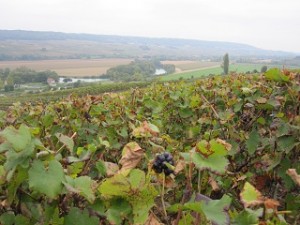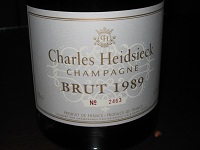The second week of this course should be called Champagne Immersion. We are in Reims, home of bubbly, and the stuff practically flows down the streets in rivers. Not that I am complaining.
We start the week off at les caves of Charles Heidsieck Champagne, with no less than two “Jeroboams” of the 1989 vintage. The “Jeroboam” refers to the three litre size of the bottle – holding four regular size bottles, or two “magnums”. I am only going to buy my champagne in this size from this day forward.
The head of Maison Charles Heidsieck, Regis Camus, explains to us that 1989 was a spectacular vendage, due to a warm and sunny summer, and a cool yet temperate fall harvest season. Coincidentally, this was the summer that Cameron and I spent backpacking around Europe – and I concur that it was a very special summer indeed. The Champagne looks like liquid gold, it’s colour so intense. It smells almost of roasted coffee and honey and is full of flavour. We are drinking twenty-one year old Champagne – what a way to get an evening started!
I somehow score a seat next to M. Camus at the ensuing Champagne and food pairing dinner, and soak up all I can. He is happy to share his passion for his favourite beverage, and takes his champagne very seriously.
“My job is extremely dangerous!” I am imagining corks blowing off of bottles at unexpected moments – apparently they are travelling at 50km/hr when they “pop”. Instead, he is referring to the amount of Champagne he is required to taste on any given day. Most mornings he and his team taste either Champagne or “Vins Clairs”, the wines used to make Champagne, until lunch.

Champagne can be made from the three varieties grown in the region – Chardonnay, Pinot Noir and Pinot Meunier. They can be made alone or in combination. The houses make wines from the grapes harvested, known as “les vins clairs”. These wines are then blended, often using older vintages (some up to ten years old), to stay consistent with the flavour profile of the brand. Have a look – most Champagne you buy does not have a vintage on it – as it is in fact made up of a blend of potentially many years. Every now and then, to mark a particularly good year, a house may decide to release a vintage – Champagne made exclusively with that year’s harvest.
“Glasses are extremely important! Do not underestimate this!” I had asked why we were served the 1989 vintage in a Burgundy red wine glass and not a flute. “This is a very big wine, it needs a big glass!” He warns me, pointing his finger at me, not to get too carried away with this notion, and to be vigilant not to put a small wine in too large a glass. He demonstrates by placing the 2002 Blanc de Rouges from Thienot in a large glass. “See? It simply does not work! This glass is much too large for this wine!”
Temperature is critical. The 1989, and none of the following four vintages served are overly cool. Apparently we are to discard our notions of ice cold champagne, and serve it around twelve degrees. If too cold we are not able to fully appreciate the aromas and the subtleties of flavour.
And of course the bubbles. Where to start?
There are two schools of thought on the bubbles.
We have a lecture on the dynamics of bubbles in Champagne, given by a professor of physio-chemistry and applied oenology at the University of Reims. We like to call him “The Bubble Guy”, and clearly he is in the camp of favouring effervescence.
The bubbles are formed by the carbon dioxide which is “dosed” into the bottle after the second fermentation. Many consumers mistakenly perceive the fineness of the bubbles to be a sign of quality. In fact, the bubbles in beer are much smaller than those in Champagne. Bubbles will be smaller in an older vintage, as the carbon dioxide dissipates during aging. Small particles of dust in the glass trap carbon dioxide and form bubbles, usually at a rate of ten “boules” per second, and they will continue to form for well over five hours.
In the other camp, is M. Camus – who has been at the helm of Charles Heidseick for over fifteen years. During dinner he tells us a story about decanting champagne into a carafe this summer, and what a fabulous drinking experience it was.
“But what about the bubbles?????”
“Who cares!!!” he shrugs. Champagne is a wine, a wine to be enjoyed, to be shared with friends, to be drunk at meals. “Just enjoy the Champagne! Don’t worry about the bubbles – they are not going anywhere.”
